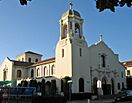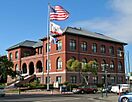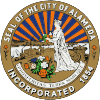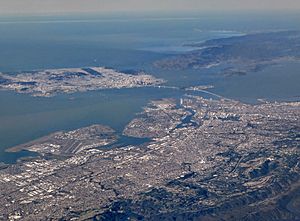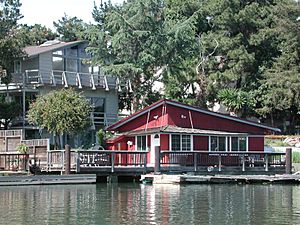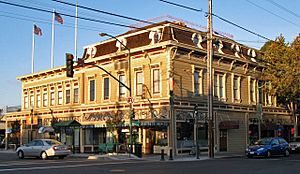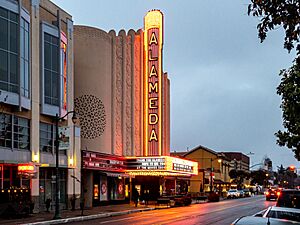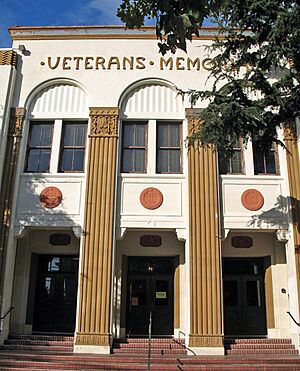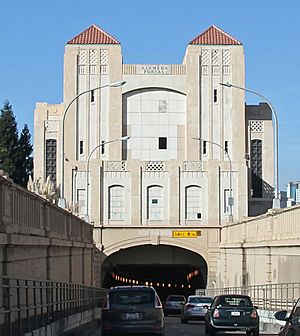Alameda, California facts for kids
Quick facts for kids
Alameda
|
|||
|---|---|---|---|
|
|
|||
|
|||
| Nickname(s):
The Island City
|
|||
| Country | United States | ||
| State | California | ||
| County | Alameda | ||
| Founded Incorporated |
June 6, 1853 April 19, 1854 |
||
| Government | |||
| • Type | Council–manager | ||
| Area | |||
| • Total | 22.98 sq mi (59.52 km2) | ||
| • Land | 10.45 sq mi (27.06 km2) | ||
| • Water | 12.53 sq mi (32.45 km2) 53.79% | ||
| Elevation | 33 ft (10 m) | ||
| Population
(2020)
|
|||
| • Total | 78,280 | ||
| • Density | 7,491.63/sq mi (2,892.62/km2) | ||
| Demonym(s) | Alamedan | ||
| Time zone | UTC−8 (Pacific) | ||
| • Summer (DST) | UTC−7 (PDT) | ||
| ZIP Codes |
94501–94502
|
||
| Area code | 510, 341 | ||
| FIPS code | 06-00562 | ||
| GNIS feature IDs | 277468, 2409669 | ||
Alameda (pronounced AL-ə-MEE-də) is a city in Alameda County, California, United States. It is located in the East Bay area of the Bay Area. The city is built on several islands in San Francisco Bay. These include Alameda Island, Bay Farm Island, and Coast Guard Island. As of the 2020 census, about 78,280 people live in Alameda. The name "Alameda" comes from a Spanish word meaning "tree-lined path."
Contents
History of Alameda
Early Days and Name Origin
The land where Alameda is now was once a peninsula connected to Oakland. It had many low, marshy areas. But higher ground was home to one of the world's largest oak forests. Because of these trees, the area was first called Encinal. This is a Spanish word for "forest of evergreen oak."
The name Alameda means "grove of poplar trees" or "tree-lined avenue." People chose this name in 1853 by voting.
Native People and Spanish Rule
When the Spanish arrived in the late 1700s, the Ohlone tribe lived here. The peninsula became part of a huge land grant called Rancho San Antonio. The Spanish king gave this land to Luis Peralta in 1820. Later, the new Republic of Mexico confirmed this land grant.
Over time, the area was also known as Bolsa de Encinal or Encinal de San Antonio.
Founding and Growth
The city of Alameda was founded on June 6, 1853. It started as three small settlements. "Alameda" was the village at Encinal and High Streets. Hibbardsville was a ferry and shipping spot. Woodstock was near the ferry piers of the South Pacific Coast Railroad and Central Pacific.
The Central Pacific's ferry pier later became the Alameda Mole. This was a major hub for ferries to San Francisco and local trains. The first post office opened in 1854. Schools like Schmermerhorn School (now Lincoln School) and Encinal School opened soon after.
Railroad and Island Status
The Alameda Terminal was a very important place. On September 6, 1869, the first train from the First Transcontinental Railroad arrived here. This connected the San Francisco Bay Area to the eastern United States. Two months later, the main train stop moved to the Oakland Mole.
In 1872, Alameda's borders grew to cover the entire island. This included Woodstock. The famous writer Mark Twain once called Alameda "The Garden of California."
In 1902, a canal was dug through the marshland between Oakland and Alameda. This turned Alameda into a true island. Much of the soil from the canal was used to fill in nearby marshy areas. Today, Bay Farm Island is no longer a separate island. It is connected to Oakland by filled land.
Neptune Beach Amusement Park
In 1917, a fun place called Neptune Beach was built. It was like Coney Island and was very popular in the 1920s and 1930s. The park was known for inventing the American snow cone and the popsicle. They also gave out special Kewpie dolls as prizes.
Neptune Beach had two huge outdoor pools. Famous swimmers like Olympian Johnny Weissmuller (who played Tarzan) and Jack LaLanne swam there. The park closed in 1939. This was due to the Great Depression, the new San Francisco–Oakland Bay Bridge, and people finding ways to sneak in.
Some buildings from the Neptune Beach era still exist. The Croll Building was a famous training spot for boxing champions. Today, it houses Croll's Pizza.
In the 1930s, Pan American Airways started a seaplane port in Alameda. This was the original home for the famous China Clipper flying boat.
The Naval Air Station Alameda (NAS Alameda) was built during World War II. It was a large naval base with an airfield and docks for aircraft carriers. This important facility closed in 1997.
In 1973, a US Navy jet crashed into an apartment building in Alameda. This tragic event resulted in the loss of eleven lives.
Today, Alameda is known as a "Coast Guard City." This means it has a special connection to the United States Coast Guard.
Geography
Alameda is often called "The Island City." However, it is actually made up of two islands and a small part of the mainland. The main part is Alameda Island. This includes the former Naval Air Station Alameda (now "Alameda Point") and the Southshore area. Bay Farm Island is also part of the city.
Most of Alameda Island is within the city limits. But a tiny piece of land near the former Naval Air Station extends into San Francisco Bay. This small part is actually in the City and County of San Francisco.
Coast Guard Island is a small island between Alameda Island and Oakland. It is home to the Integrated Support Command Alameda and is also part of the city.
Climate
Alameda has a mild climate. Summers are warm and dry, but not too hot. The average monthly temperature never goes above 71.6°F (22°C). This is called a warm-summer Mediterranean climate. It rains about 20 inches a year, mostly as rain. Snow is very rare near the bay.
Demographics
| Historical population | ||
|---|---|---|
| Year | Pop. | ±% |
| 1860 | 460 | — |
| 1870 | 1,557 | +238.5% |
| 1880 | 5,708 | +266.6% |
| 1890 | 11,165 | +95.6% |
| 1900 | 16,464 | +47.5% |
| 1910 | 23,383 | +42.0% |
| 1920 | 28,806 | +23.2% |
| 1930 | 35,033 | +21.6% |
| 1940 | 36,256 | +3.5% |
| 1950 | 64,430 | +77.7% |
| 1960 | 63,855 | −0.9% |
| 1970 | 70,968 | +11.1% |
| 1980 | 63,852 | −10.0% |
| 1990 | 76,459 | +19.7% |
| 2000 | 72,259 | −5.5% |
| 2010 | 73,812 | +2.1% |
| 2020 | 78,280 | +6.1% |
| 2023 | 75,353 | −3.7% |
| U.S. Decennial Census | ||
Population in 2020
| Race / Ethnicity | Pop 2000 | Pop 2010 | Pop 2020 | % 2000 | % 2010 | % 2020 |
|---|---|---|---|---|---|---|
| White alone (NH) | 37,921 | 33,468 | 32,152 | 52.48% | 45.34% | 41.07% |
| Black or African American alone (NH) | 4,350 | 4,516 | 4,399 | 6.02% | 6.12% | 5.62% |
| Native American or Alaska Native alone (NH) | 365 | 247 | 173 | 0.51% | 0.33% | 0.22% |
| Asian alone (NH) | 18,757 | 22,822 | 25,107 | 25.96% | 30.92% | 32.07% |
| Pacific Islander alone (NH) | 407 | 342 | 356 | 0.56% | 0.46% | 0.45% |
| Other race alone (NH) | 235 | 278 | 556 | 0.33% | 0.38% | 0.71% |
| Mixed race or Multiracial (NH) | 3,499 | 4,047 | 6,102 | 4.84% | 5.48% | 7.80% |
| Hispanic or Latino (any race) | 6,725 | 8,092 | 9,435 | 9.31% | 10.96% | 12.05% |
| Total | 72,259 | 73,812 | 78,280 | 100.00% | 100.00% | 100.00% |
Population in 2010
The 2010 United States Census showed that Alameda had 73,812 people. About 98% of the people lived in homes. The rest lived in group housing or institutions.
There were 30,123 households. About 30% of these had children under 18. Many households were married couples. Some were single-parent homes or people living alone. The average household had 2.40 people.
The population's age spread was diverse. About 20% were under 18. Many people were between 25 and 64 years old. The median age was 40.7 years.
Alameda has a large Filipino community. There is also a big Portuguese community. The city also has a historic Japanese American community. Before World War II, there was a small Japanese business area on Park Street. A Japanese Buddhist church is one of the few buildings left from that time.
Economy
The former Naval Air Station Alameda (NAS) closed in 1997. This land was given to the City of Alameda for new development. It is now known as Alameda Point.
The aircraft carrier USS Hornet is now a museum ship. It has been docked at the former Naval Air Station since 1998. It is called the USS Hornet Museum.
A group of small businesses making spirits, wines, and beers is located on Monarch Street at Alameda Point. This area is called "Spirits Alley." Admiral Maltings is also here. It is California's first craft malting house, supplying brewers and whisky makers.
Top Employers
Here are the top employers in Alameda, based on a 2020 report:
| # | Employer | # of Employees |
|---|---|---|
| 1 | Penumbra Inc. | 1,839 |
| 2 | Alameda Unified School District | 1,068 |
| 3 | Alameda Hospital | 750 |
| 4 | Abbott Diabetes Care Inc. | 565 |
| 5 | City of Alameda | 543 |
| 6 | Kaiser Foundation Health Plan | 450 |
| 7 | U.S. Department of Transportation | 370 |
| 8 | Alameda Alliance For Health | 366 |
| 9 | Bay Ship & Yacht Co. | 316 |
| 10 | College of Alameda | 266 |
Arts and Culture
The Alameda Arts Council (AAC) helps support local arts. The Alameda Civic Ballet is the city's ballet group. The Alameda Museum shows displays about Alameda's history. The Alameda Art Association has a gallery at South Shore Center mall.
Theaters
The city restored the historic Art Deco Alameda Theatre. It was expanded to include a movie theater complex. It opened to the public on May 21, 2008.
The Altarena Playhouse performs comedies, dramas, and musicals. It started in 1938. It is the oldest continuously running community theater in the San Francisco Bay Area.
Festivals
Alameda's Fourth of July parade is very famous. It is said to be the second oldest and second longest Fourth of July parade in the United States. It features creative homemade floats, classic cars, and marching bands.
Three big events close the historic downtown street to cars. The Park Street Spring Festival happens every May. It attracts over 50,000 visitors. The Park Street Art & Wine Faire is in late July. It brings in over 100,000 visitors. The Park Street Classic Car Show is held every October. It displays over 400 old cars.
The annual Sand Castle and Sculpture Contest takes place in June. It is held at the Robert Crown Memorial State Beach. The first contest was in 1967.
Education
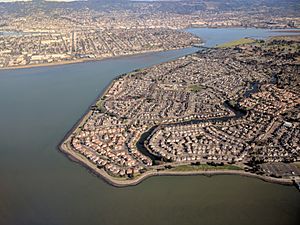
Public schools in Alameda are managed by the Alameda Unified School District. This district is separate from the city government. The College of Alameda is a two-year community college. It is part of the Peralta Community College District. The city also has many private elementary schools. There is one private high school, St. Joseph Notre Dame High School, which is a Catholic school.
Media
Alameda's first newspaper was the Encinal in the 1850s. Over time, other papers appeared. The Daily Argus became well-known. Later, The Times and The Star combined to form the Alameda Times-Star.
Between 2001 and 2023, the Alameda Sun was a local weekly newspaper. Today, the community is served by the weekly newspaper, the Alameda Journal. There is also an online news outlet called the Alameda Post.
Transportation
You can reach Alameda Island by car using three bridges from Oakland. These are the Park Street, Fruitvale Avenue, and High Street Bridges. There are also two one-way tunnels, the Posey and Webster Street Tubes. These lead into Oakland's Chinatown.
To get from Alameda to Bay Farm Island, you can use the Bay Farm Island Bridge. There is also a special bridge just for bikes and pedestrians. This is the only pedestrian/bicycle-only drawbridge in the United States.
California State Route 61 runs through Alameda. The island is also very close to Interstate 880 in Oakland. The speed limit in the city is usually 25 mph (40 km/h).
Public transportation options include:
- AC Transit buses: These buses connect Alameda to Oakland, Berkeley, and even San Francisco.
- Ferry services: Ferries go from Alameda to Oakland and San Francisco. These are run by the Water Transit Authority.
- BART stations: The closest BART stations are Lake Merritt, 12th Street, and Fruitvale.
Notable Buildings
- Alameda City Hall; listed on the National Register of Historic Places (NRHP)
- Alameda High School; NRHP-listed
- Croll Building; NRHP-listed and a California Historical Landmark
- Masonic Temple and Lodge; NRHP-listed, and part of the Park Street Historic Commercial District
- Park Street Historic Commercial District; NRHP-listed and a California Historical Landmark
Notable People
Many interesting people have connections to Alameda:
- Norman Allinger, a chemist, was born here.
- John Baker, an MLB catcher, was born in Alameda.
- Virginia Lee Burton, a children's author, lived here.
- Harold Camping, a radio personality, lived here.
- Phyllis Diller, a comedian, lived in Alameda.
- General James Doolittle, a World War II hero, was born in Alameda in 1896.
- Leif Erickson, an actor, was born here in 1911.
- Debbi Fields, who started Mrs. Fields Cookies, went to Alameda High School.
- Albert Ghiorso, a nuclear scientist who discovered 12 chemical elements, lived here.
- Katharine Graham, the publisher of The Washington Post, lived in Alameda as a child.
- Tim Hardaway Jr., a professional basketball player, was born here.
- Horace Heidt, a bandleader, was born in Alameda in 1901.
- Emily Heller, a comedian, grew up here.
- Marielle Heller, an actress and director, grew up here.
- Benjamin Jealous, a former NAACP President, lived in Alameda.
- Joseph R. Knowland, a congressman, was an Alameda native.
- William Fife Knowland, a U.S. Senator, was student body president at Alameda High.
- Paul Mantz, an air racer and stunt pilot, was born in Alameda in 1903.
- Margaret McNamara, who founded Reading is Fundamental, grew up here.
- George P. Miller, a congressman, lived here.
- Don Perata, a former State Senator, lives in Alameda.
- Bill Rigney, an MLB player and manager, was born here.
- Dutch Ruether, a pitcher for the 1927 New York Yankees, was born here.
- Jane Sibbett, an actress, grew up in Alameda.
- Frederica Von Stade, an opera singer, has lived here since 1992.
- Sharon Tate, an actress, lived here in the 1960s.
- Charles Lee Tilden, for whom Tilden Regional Park is named, lived here for a long time.
Many athletes also attended high schools in Alameda:
- Willie Stargell, Tommy Harper, Curtell Howard Motton, Dontrelle Willis, and Jimmy Rollins all went to Encinal High School.
- Jason Kidd and Joe Nelson attended St. Joseph Notre Dame High School.
- Ray French, Johnny Vergez, Andy Carey, Bill Serena, Erik Schullstrom, Dick Bartell, Duffy Lewis, Chris Speier, and Bryan Woo all went to Alameda High School.
Many people from naval families have lived in Alameda, including celebrities like Ann Curry, Brigette Lundy-Paine, Tom Hanks, and Jim Morrison.
Sister cities
Alameda has special relationships with cities around the world. These are called "sister cities." They help people from different countries understand each other better.
 Jiangyin, China
Jiangyin, China Arita, Japan
Arita, Japan Yeongdong-gun, South Korea
Yeongdong-gun, South Korea Lidingö, Sweden. This partnership started in 1959. Both Alameda and Lidingö are islands connected to a big city by a bridge.
Lidingö, Sweden. This partnership started in 1959. Both Alameda and Lidingö are islands connected to a big city by a bridge. Dumaguete, Philippines
Dumaguete, Philippines Varazze, Italy
Varazze, Italy
Friendship city
 Wuxi, China (This is a "friendship city" since 2004.)
Wuxi, China (This is a "friendship city" since 2004.)
See also
 In Spanish: Alameda (California) para niños
In Spanish: Alameda (California) para niños


